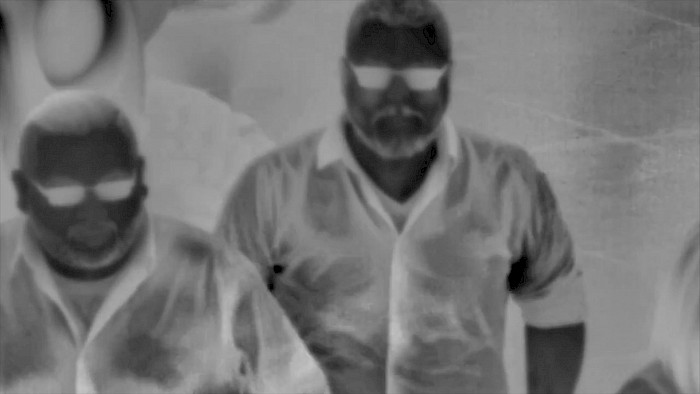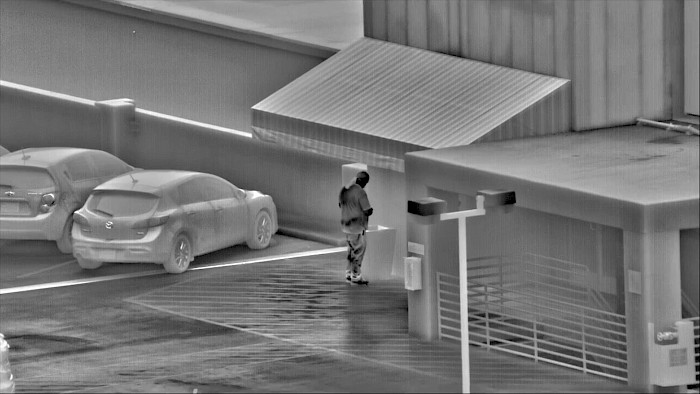Shown in Competition #1.
Synopsis
Public light rips through the night of a modern city. Sleeplessness is lit up by a computer monitor in an urban space, where day and night are no longer distinguished.
Documentation
Can you explain the technical process you used for this film?
This film is a found footage film, so the technical part of is quite simple but perhaps i can elaborate about of my way into this project.
In making the film, I had a desire to talk about the military industrial complex. Recognising the existence of this infrastructure and economy between private contractors, state and military. At least to recognise its existence which is seldomly talked about. At the same time i also let myself be very intuitive in the process of making the film, including a narrative of my own current experience of the world. In that way I wanted to include even the process of making this film and looking through material (and my own response) into the final narrative.
Covid closed down Europe around the time I was finishing the edit of the film. A few months later George Floyd was brutally murdered in the US and sparked massive protests and one of their demands and chants was ‘Defund the police’. All of this definitely affected the final stretch of the film and somehow even the glow of the images. I was already looking into the military (police) industry complex and so I made it a point in the final credits of the film to give an example of how the current situation also fuels this industry tremendously. I guess my starting point was with the rise of surveillance technologies and its connection to the military industrial complex and for that reason I also don’t specifically mention Covid, since it is not why the film was made. Instead I guess it shaped my view on all the events that happened (and are still happening) afterwards.
The film opens with a voice singing Viva Las Vegas from Elvis Presley in a sleepy karaoke version. The original song has this fast paced banjo silliness to its verses and an overall feeling of carelessness and the idea to include it in the film began a bit as a joke. Later, in the making of the film, I had a closer look at the lyrics of the song and I found a peculiar resemblance to both the narrative, that I was already working on, and also to the features of the thermal camera that I was pondering about. The song is basically Elvis describing how he is being swallowed by the city. The bright light sets his soul on fire, how he stopped sleeping and how he will Never Be The Same Again. The song opens with Bright Light City Gonna Set My Soul, Gonna Set My Soul On Fire and as the first chapter of the film talks about light stimuli as a tool for crowd control, I decided to open the film with the same lyrics. To me ‘light’ in this case becomes a symbol of several things. The film mentions that light became a symbol of prosperity and security at the end of the 17th century and that, in this constant search for illumination also arose a blindness. To me the same blindness is also contained in the clips used in the film – the confused man walking aimlessly on the construction site, the surveilled characters of the film in a constant search for entertainment, the ongoing act of looking at phones (light, entertainment, endorphin kicks) and taking selfies and the sheer act of the military company illegally surveilling these people to create promotion material. Also the lyrics mention how Las Vegas is Turning Day Into Nighttime, Turning Night Into Daytime, the same dissolvement of night and day happens through the recordings of the thermal camera.
In that sense I think Las Vegas is an interesting geographical starting point for a discussion about surveillance. The cliche saying goes What Happens In Las Vegas, Stays In Las Vegas. People are attracted to the city and its light because of its promise of untamed behavior. In Las Vegas you can forget about the triviality of life for a brief moment and live like there’s no tomorrow, exactly like Elvis Presley in the song. Another reality will tell you that Las Vegas is one of the most surveilled places in the world and that literally your every move will be registered and Stay in Las Vegas. I think this schesim is what fascinates me about these images. As a western society we want to be free as individuals and on the surface everything tells you that we are, but underneath or in this case above the characters, is a silent recording happening.
I think I definitely have a nostalgia to a more untamed time in history. The examples in the text of Elvis Presley or OJ. Simpson stands as a representation of time long gone. The two of them are also representations of another kind of blindness connected to the entertainment industry. In the case of OJ. Simpson and the car chase scene that i mention in the film, people were out on the street cheering for him despite the overwhelming evidence against him. They loved him for his achievements in sports and through all of the products that he endorsed – they loved him through the television screen.
The idea for the voice over is this ‘note-to-self’ recording on a dictaphone. The dictaphone also adds to the feeling of nostalgia, to me it adds to a kind dissolvement of time, almost as a bottle mail found on a beach. The idea came through the texture of the grey-scaled thermal images and the movement of the characters The texture and color reminds me of black and white film from the 50’s or 60’s. But then the way people move, the lack of shadows and the fact that these cameras can’t penetrate glass, gives the sense that you are inside a contemporary video game. This contrast definitely inspired the narrative that allows itself to jump in time and space.
Why did you choose such a visual aesthetic to describe urban spaces?
The visual aesthetic of the long range thermal camera was somehow fitting to the narrative of my film. The writing of the narrative of the film was definitely informed by the images and the editing and writing somehow happened simultaneously. To me the visual aesthetic of the thermal camera also brings a certain unreal computer rendered feel to the images. This hopefully enables the viewer to be swept into a dreamlike state where the boundary between the dream and awake-state is blurred out. On a more grounded answer, I chose videos made from a military camera because one of the main themes of the film is the link between surveillance industry and the military industry complex.The gaze of film is then already militarised and having this camera shifted back on the western society (and not a dessert in the middle east) creates an interesting friction in the images.
Another reason why i chose these exact clips, was the fact that they reminded me of a recurring dream of mine that I used to have for many years. Since the camera operator constantly is struggling to make sure the image is sharp, the clips consist of many attempts to pull the right focus. This focus pulling immediately reminded me of my dream in which I am also constantly rubbing my eyes to sharpen my sight. A claustrophobic, blurry dream in which I am stuck inside my mind not able to communicate with the people around me. This dream is also infiltrated in the narrative but more than that, the concept of the dream or nightmare inspired many of the narrative decisions. I haven’t experienced lucid dreaming but having talked to people who have, I was also fascinated by their reports. A friend of mine told me of his ability to connect in all these threads (politics, media, historic events, personal, cosmic etc.) and see more clearly how his life had shaped him up until now. Like this huge influx of ideas and inputs that enabled a great comprehension of the contemporary world. Almost impossible to retell with the limits of language and our general understanding of time. This definitely also inspired the narrative of my film at least on a subconscious plan.



